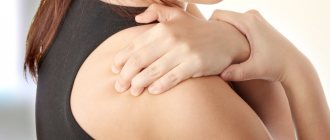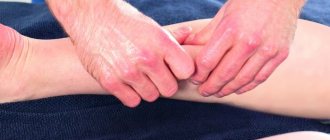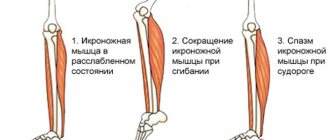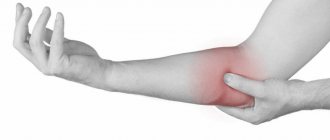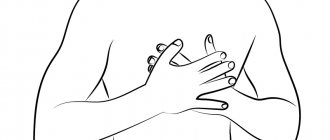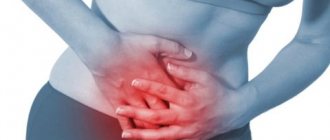Muscle fatigue
In our technological age, many people are gradually forming a new “bad habit”. Spending most of the day in front of a computer screen or holding mobile gadgets in our hands, we may not even notice that we are sitting in a completely uncomfortable and unnatural position. It especially affects the muscles of the shoulder girdle, neck, back and right arm, which is constantly on the computer mouse of office workers1. Staying in one position for a long time or using stereotyped movements can lead to overstrain of the muscles involved, which we feel as soreness1.
Venous thrombosis
The occurrence of pain during thrombosis (blockage of a vein with a blood clot) is promoted by inflammation of the vessel wall or surrounding tissue. In addition, impaired outflow can lead to swelling and discoloration of the skin (pallor, cyanosis, redness). Pallor can be detected in the early stages of thrombosis of the veins of the iliofemoral region. Cyanosis is caused by congestive hypoxia and, as a rule, occurs with obstruction of the proximal veins of the leg. Pain during thrombosis can be aching, sharp or dull, intense and moderate. Often the pain intensifies when walking or carrying heavy objects. Pain may be relieved by lying down with your legs elevated. With superficial vein thrombosis, diagnosis is not difficult. If there is a suspicion of deep vein thrombosis, then objective research methods are necessary.
Exercise stress
“Body aches” after physical activity can occur both in untrained people and in professional athletes8. And the cause of discomfort is the accumulation of under-oxidized metabolic products in muscle cells; in particular, painful sensations are caused by an excessive amount of lactic acid (lactate)2. Less commonly, the cause is microtrauma, but this can only occur if the training rules are violated8.
Muscle soreness due to overwork does not occur immediately, but after a few hours or within 1-2 days after training or unusual physical activity and disappears within a week8.
Neuropsychic exhaustion
Sometimes the cause of muscle pain is nervous exhaustion. During the examination, doctors do not find any organic pathology, since the trigger is emotional instability.
Such patients experience the following symptoms:
- increased anxiety;
- irritability;
- insomnia;
- breathing problems;
- arrhythmia;
- decreased sex drive, etc.
In such a situation, a consultation with a psychotherapist is required. The doctor will create an effective treatment program.
Injuries
Severe pain can occur when muscle fibers and tendons are torn. This usually happens if the load is excessive and the muscles are not prepared for it1. But they can also be damaged by sudden movements3. Unlike “ache” due to muscle overwork, pain due to injury occurs immediately, at the peak of the load3.
It should be remembered that even a small, but untreated injury can cause an even more severe sprain3. Therefore, if you experience pain during physical activity, be sure to consult a doctor to rule out a serious injury.
to come back to the beginning
First aid
The most correct option is to contact an osteopathic specialist who will help you completely get rid of the problem. Only a professional can correctly diagnose, find the cause of muscle pain and offer effective treatment. However, for one reason or another, we cannot always get an urgent appointment with a doctor. Therefore, it is important for each person to know a number of ways that will help, if necessary, relieve pain on their own until the moment when it becomes possible to receive specialist advice and treatment. For exacerbations that are the consequences of stress, excessive training in the gym, or overexertion at work, the following method is suitable.
We must leave the sore spot alone. For three days, avoid any physical activity due to pain. At the same time, there is no need to check every minute to see if improvements have appeared. We have this habit: touching the sore spot, pressing on it, checking to see if the pain has suddenly gone away. And if it doesn’t go away, we start to panic. The treatment method “moving through pain” is not suitable for this case. Sharp pain is a sign that a muscle spasm has occurred. To eliminate this, it is necessary to perform a set of measures aimed at maximizing muscle relaxation. The simplest and most effective way is heat. The muscle must be warmed to cause it to relax. Cold, on the contrary, causes tension. I think you all know “grandmother’s” recipe: lower back wrapped in a downy scarf, a heating pad, rubbed feet in woolen socks. This is not a relic of the past, but an effective method that has been proven over the centuries. So, in order to eliminate pain, it is necessary to influence not only the place where the pain actually occurred, but also the entire body. A bath or sauna is an excellent method of combating cramps. But avoid dousing with ice water or cold baths. As I already said, cold provokes tension; sudden cooling of the body after a hot bath will not allow you to get the desired result.
Recover your muscles! How to “pump up” your body to live a long and high-quality life More details
If it is not possible to visit the bathhouse, there is a “home” alternative: a hot bath. Just don’t wait until the water cools down: the procedure must be completed while the water is warm. After taking a bath, dry yourself immediately, put on a T-shirt, pants (cotton ones are best), pajamas, and a suit or something warm on top. And in this “outfit” spend some time under a warm blanket. You need to sweat a lot. Don't forget to change your clothes after this. This procedure should be repeated for two to three days. If you do everything correctly, there will definitely be an effect. This does not apply only to those cases when the cause of pain is a strangulation of the hernia root. But in any case, if after one hot bath you do not feel any changes, do not panic.
Article on the topic
Unstable gymnastics. We work the muscles in an unusual way. In addition, eliminate physical activity that causes pain. Walking is a kind of therapeutic procedure during which self-massage occurs: while walking, all ligaments, muscles, bones and joints are exercised and massaged. Stretching is acceptable for physical activity. With its help, you will work out the main muscle groups, stretching will improve blood circulation, ensure muscle elasticity and reduce the risk of injury. Taken together, all these measures will help you relax your muscles and, accordingly, relieve severe pain.
If muscle pain occurs due to severe injury or pinched nerve root and is not relieved using these methods within several days, you should urgently consult a specialist.
Diseases of the spine and joints
Muscles react to disruption of the joints4 and vertebrae5 associated with them. Therefore, myalgia is one of the symptoms of diseases of the spine5,11 and joints of the limbs4. For example, with osteochondrosis or scoliosis (curvature of the spine), pain in the neck, chest or lower back is associated with overstrain of the paravertebral muscles5,11. And in advanced cases, when the vertebra compresses the nerve root emerging from the spinal cord, the pain can “radiate” to the arm or leg11.
Often myalgia with osteochondrosis is combined with a feeling of numbness or “crawling goosebumps”. At the moment of acute pain, a person freezes, taking a forced position11.
Dermatomyositis
This disease develops gradually. Muscle pain is preceded by the following symptoms:
- feeling of weakness in the neck;
- decreased muscle strength in the forearms and thighs;
- swallowing reflex and speech disorder;
- difficulty breathing;
- inflammation in the mucous membranes;
- the appearance of a rash on the back of the hands and feet, in the joints, on the face, neck and back;
- expansion of subcutaneous capillaries.
Later, dermatomyositis manifests itself as pain throughout the body, accompanied by severe weakness and impaired self-care.
Other reasons
Almost any disease of the internal organs can lead to myalgia11. When an organ is affected, it creates pain impulses that are partially transmitted to the muscles located nearby11.
Myalgia can also be caused by:
- endocrine diseases, such as thyroid hormone deficiency16,7;
- vascular pathologies that disrupt the nutrition of the muscles of the limbs15,16;
- chronic fatigue syndrome7;
- imbalance of microelements in the body16;
- taking medications that lower blood cholesterol levels12.
to come back to the beginning
Restless legs syndrome
Restless legs syndrome is a condition in which the patient experiences discomfort from the position of the legs and, sometimes, an irresistible urge to move the legs. This syndrome can lead to sleep disturbances and interfere with daily life.
Patients describe their sensations as the touch of needles in their legs, and sometimes as nagging pain. Changing the position of the legs brings temporary relief. Most often, these sensations occur in the evening, when a person is trying to relax or go to bed. The cause of this syndrome is not known. Certain medications (such as antidepressants), pregnancy, or iron deficiency (anemia) may cause this syndrome. Restless legs syndrome is treated with drugs that increase dopamine levels in the brain (levodopa) or anticonvulsants (gabapentin) to control leg movements and improve sleep. Opiates are extremely rarely used.
Features of myalgia
Pain emanating from the muscles is usually deep6. Acute myalgia is protective in nature because it causes reactions aimed at eliminating the damaging factor11. Such reactions include, for example, muscle spasms4. But despite its protective nature, there is almost always a risk that the pain will become chronic11. There are 2 main causes of chronicity:
- Increased sensitivity. In response to irritation, the muscle releases substances that support inflammation. They further irritate pain receptors in the muscles. In response to frequent signals, the central nervous system lowers the pain threshold, so we can feel soreness in the muscle even when it is not strongly irritated11.
- Spasm. If pain and spasm persist, a “vicious circle” is formed: pain causes spasm, and spasm maintains pain1,5, 11.
Bone damage
Damages to the bone tissue of the lower extremities (tumors, subperiosteal hematomas, fractures) may be accompanied by pain, tenderness to the touch, and swelling of the limb. Clinical manifestations may be similar to venous thrombosis. It can be especially difficult to diagnose a hip fracture in older people (the fracture is often accompanied by swelling of the lower limb). Considering the involutional changes in the central nervous system (cerebral vascular sclerosis), it is sometimes difficult to collect an anamnesis in this category of patients. In addition, elderly people often have a combination of a femoral neck fracture with venous thrombosis.
Diagnosis of muscle pain
Determining why myalgia occurs is not always easy. Only a doctor can understand the causes and select treatment that helps get rid of disturbing symptoms or alleviate them. To find out the cause of myalgia, the doctor conducts a comprehensive examination, including a neurological one, prescribes laboratory tests, ultrasound, computed tomography and other research methods3.
Various specialists treat myalgia. Depending on its cause, a traumatologist, rheumatologist, neurologist or endocrinologist can help you.
Rupture of popliteal cyst (Baker's cyst)
The fluid contained in a Baker's cyst, when ruptured (in the case of injury, arthritis or surgery in the knee joint), can flow down into the intermuscular space and cause an inflammatory reaction. This may manifest itself as pain, swelling in the lower leg, tenderness on palpation and resemble the picture of venous thrombosis. Rupture of a Baker's cyst can occur without provoking reasons. The diagnosis can be made based on radiography. But the possible combination of cyst rupture and venous thrombosis requires first of all the exclusion of thrombosis.
Treatment
Treatment of leg pain directly depends on the disease and can be either conservative (drug treatment, intra-articular injections, physiotherapy, acupuncture, exercise therapy, orthotics) or surgical. The following recommendations can be preventive:
- No smoking
- Don't abuse alcohol
- Monitor blood sugar levels (if you have diabetes)
- Control cholesterol levels
- When exercising, a mandatory warm-up before and sufficient rest after exercise
- Drinking enough fluids during exercise.
Author: V.I. Dikul
